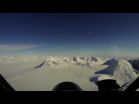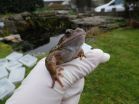This Arctic field season, IceBridge, NASA's twice-yearly airborne survey of polar ice, carried out 33 eight-hour flights during ten weeks, collecting data over sea and land ice regions that have been evolving rapidly over the last decades. The mission also conducted over a dozen international research collaborations and released two sea ice data products that will help scientists forecast how Arctic sea ice will behave during the summer.
"We achieved good coverage of our sea ice target areas, northern Greenland and Arctic Canada, and excellent coverage of land ice targets in southern Greenland," said John Sonntag, Operation IceBridge's Field Team Lead, from NASA's Goddard Space Flight Center in Greenbelt, Maryland.
A Look At Sea Ice
IceBridge's first science flight took place on March 19 and it included an overflight of the Norwegian icebreaker Lance, to provide a comparison between in situ and airborne sea ice observations. Every year, the initial part of the campaign is dedicated to overflying the Arctic basin's sea ice cover from two sites: Thule Air Base in northwest Greenland and Fairbanks, Alaska.
This Arctic season, IceBridge completed all of its sea ice baseline flights -missions that are repeated year after year - but one, the so-called North Canada Basin mission, which had been modified to fly under the orbit of SARAL, a French-Indian satellite - the objective was to compare the data the satellite and IceBridge would have collected simultaneously over the same flight line.
" Our number one goal always is to get a very good feeling for the distribution of the thickness of the sea ice cover in the Western Arctic, and that primary mission was accomplished," said Jackie Richter-Menge, IceBridge science team co-lead and sea ice researcher with the U.S. Army Corps of Engineers Cold Regions Research and Engineering Laboratory in Hanover, New Hampshire.
Since 2012, IceBridge has been releasing a quick analysis of its sea ice thickness data. Last year, the IceBridge team started producing a second data product that relates IceBridge's regional measurements with more global data from the European Space Agency's satellite, CryoSat-2, to show ice thickness across the entire Arctic Ocean.
"The stated goal of Operation IceBridge is to bridge NASA's ICESat and ICESat-2 satellite missions, but now we also have CryoSat-2 in the mix -- and that's an important part to keep in mind," said Nathan Kurtz, a sea ice scientist at NASA's Goddard Space Flight Center in Greenbelt, Maryland. Kurtz, who recently became Operation IceBridge's project scientist, said that IceBridge's measurements of ice and snow on ice have already been used to inform CryoSat-2 retrievals.
Both the quick-look IceBridge and CryoSat-2 sea ice thickness data sets, which are publicly available on the website of the National Snow and Ice Data Center, are released before the end of the Arctic campaign and they feed models that try to forecast how the sea ice cover is going to melt over the summer.
"The better the observational data on the conditions of the sea ice cover at the beginning of the melt season, the better the models perform," Richter-Menge said.
Overflying Land Ice
The second part of the campaign was based in Kangerlussuaq, in southwest Greenland. From there, the C-130 carried 16 flights to collect data on ice surface elevation and thickness at several rapidly changing points of the Greenland ice sheet, such as the Jakobshavn Glacier catchment, the Geikie Peninsula, and all the major glaciers in southeastern Greenland.
Every field season, IceBridge conducts collaborations with other science teams: in some cases, the goal is to compare the data IceBridge collects from the air with the measurements other teams take, either from the ground or through satellites. Other times, IceBridge's observations help researchers conducting fieldwork to pinpoint places on the sea ice or the Greenland ice sheet where they will locate their experiments.
This year, IceBridge was able to deliver freshly collected data almost immediately to two field teams. One of them was a Danish group that was planning on drilling a deep core on the Renland ice cap in east Greenland. During one of its missions, IceBridge flew two passes over the small ice cap and took radar measurements of the potential drilling sites with its Multichannel Coherent Radar Depth Sounder (MCoRDS) instrument.
"The day after we did the flight, I ran into one of the researchers in Kangerlussuaq, so we were able to physically put into her hands two echograms of the site she wanted to drill - these were beautiful echograms, showing with great deal of detail the internal layering of the ice cap, and also the bedrock," said Sonntag. "It was very gratifying to be able to physically hand it to the scientist and to know that her team would be able to put it into scientific use."
On another occasion, IceBridge also used MCoRDS to help a U.S. team that was studying a firn - compacted snow - aquifer in southeast Greenland to select an optimal drilling site. This group, which was camping on the ice sheet, had had trouble getting helicopter support to move their heavy drilling equipment from one possible drilling site to another.
"We saved them a huge amount of labor by helping them get a very good idea of where to focus their drilling efforts - otherwise they'd have had to move their equipment by man-hauling it across deep snow, multiple times," Sonntag said.
Reaching out
While in Thule and Kangerlussuaq, IceBridge hosted two members of the news media and a professional photographer, all of whom went on flights over sea and land ice, interviewed members of the team and joined other daily activities of the Arctic campaign.
Team researchers also participated in live, in-flight chats with classrooms in 11 U.S. states and Mexico. In total, during the 2015 Arctic campaign IceBridge scientists reached out to 35 classrooms and 723 students from fifth to twelfth grades.
The third and last part of the campaign started on April 29, when IceBridge moved its base of operations back to Thule Air Base. For the next three weeks, the mission focused mostly on land ice and collected measurements of glaciers in northwestern, northern and northeastern Greenland, ice caps on Canada's Baffin and Devon Islands, as well as one additional sea ice flight.
But bad weather over Greenland didn't allow the C-130 to fly the two remaining baseline land ice missions: a new flight surveying the Zachariae Isstrom and 79 N glaciers in northeast Greenland, and a mission along planned IceSat-2's groundtracks in west-central Greenland.
"The team accomplished a lot this season despite adverse conditions and technical problems," said Eric Rignot, IceBridge science team co-lead and glaciologist at the University of California, Irvine and NASA's Jet Propulsion Laboratory (JPL) in Pasadena, California. "We collected the required baseline missions to sample the four corners of the ice sheet and characterize the state of its mass balance and contribution to sea level in 2015."
With 33 survey flights completed, IceBridge flew back to NASA's Wallops Flight Facility in Virginia on May 22, after an overnight stop in Bangor, Maine.
The next deployment will be the Antarctic campaign, which will begin in October and will be based in Punta Arenas, Chile. From there, the National Science Foundation's Gulfstream 5 research aircraft will fly over several targets in Antarctica, carrying IceBridge's Land Vegetation and Ice Sensor (LVIS) laser instrument.
The mission of Operation IceBridge is to collect data on changing polar land and sea ice and maintain continuity of measurements between NASA's Ice, Cloud and Land Elevation Satellite (ICESat) missions. The original ICESat mission ended in 2009, and its successor, ICESat-2, is scheduled for launch in 2017. Operation IceBridge, which began in in 2009, is currently funded until 2019. The planned two-year overlap with ICESat-2 will help scientists validate the satellite's measurements. For more about Operation IceBridge and to follow future campaigns, visit:
http://www.nasa.gov/icebridge
INFORMATION:

